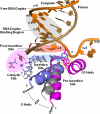Structural evidence for the rare tautomer hypothesis of spontaneous mutagenesis
- PMID: 22006298
- PMCID: PMC3203791
- DOI: 10.1073/pnas.1114496108
Structural evidence for the rare tautomer hypothesis of spontaneous mutagenesis
Abstract
Even though high-fidelity polymerases copy DNA with remarkable accuracy, some base-pair mismatches are incorporated at low frequency, leading to spontaneous mutagenesis. Using high-resolution X-ray crystallographic analysis of a DNA polymerase that catalyzes replication in crystals, we observe that a C • A mismatch can mimic the shape of cognate base pairs at the site of incorporation. This shape mimicry enables the mismatch to evade the error detection mechanisms of the polymerase, which would normally either prevent mismatch incorporation or promote its nucleolytic excision. Movement of a single proton on one of the mismatched bases alters the hydrogen-bonding pattern such that a base pair forms with an overall shape that is virtually indistinguishable from a canonical, Watson-Crick base pair in double-stranded DNA. These observations provide structural evidence for the rare tautomer hypothesis of spontaneous mutagenesis, a long-standing concept that has been difficult to demonstrate directly.
Conflict of interest statement
The authors declare no conflict of interest.
Figures



 ) captured at five different positions. λprimer and λtemplate are defined as the angle between the glycosidic bond of primer or template nucleotide and a line between the C1′ atoms of the base pair. Complete tables of all nine base-pair parameters are included (
) captured at five different positions. λprimer and λtemplate are defined as the angle between the glycosidic bond of primer or template nucleotide and a line between the C1′ atoms of the base pair. Complete tables of all nine base-pair parameters are included (


Similar articles
-
Insights into the effect of minor groove interactions and metal cofactors on mutagenic replication by human DNA polymerase β.Biochem J. 2018 Feb 9;475(3):571-585. doi: 10.1042/BCJ20170787. Biochem J. 2018. PMID: 29301983 Free PMC article.
-
Evading the proofreading machinery of a replicative DNA polymerase: induction of a mutation by an environmental carcinogen.J Mol Biol. 2001 Jun 1;309(2):519-36. doi: 10.1006/jmbi.2001.4674. J Mol Biol. 2001. PMID: 11371169
-
Extending the understanding of mutagenicity: structural insights into primer-extension past a benzo[a]pyrene diol epoxide-DNA adduct.J Mol Biol. 2003 Apr 4;327(4):797-818. doi: 10.1016/s0022-2836(03)00187-6. J Mol Biol. 2003. PMID: 12654264
-
The steric hypothesis for DNA replication and fluorine hydrogen bonding revisited in light of structural data.Acc Chem Res. 2012 Aug 21;45(8):1237-46. doi: 10.1021/ar200303k. Epub 2012 Apr 23. Acc Chem Res. 2012. PMID: 22524491 Free PMC article. Review.
-
[SOS-inducible DNA polymerases and adaptive mutagenesis].Genetika. 2004 May;40(5):581-91. Genetika. 2004. PMID: 15272554 Review. Russian.
Cited by
-
Structural factors that determine selectivity of a high fidelity DNA polymerase for deoxy-, dideoxy-, and ribonucleotides.J Biol Chem. 2012 Aug 17;287(34):28215-26. doi: 10.1074/jbc.M112.366609. Epub 2012 May 30. J Biol Chem. 2012. PMID: 22648417 Free PMC article.
-
Insights into the effect of minor groove interactions and metal cofactors on mutagenic replication by human DNA polymerase β.Biochem J. 2018 Feb 9;475(3):571-585. doi: 10.1042/BCJ20170787. Biochem J. 2018. PMID: 29301983 Free PMC article.
-
Structures of LIG1 that engage with mutagenic mismatches inserted by polβ in base excision repair.Nat Commun. 2022 Jul 5;13(1):3860. doi: 10.1038/s41467-022-31585-w. Nat Commun. 2022. PMID: 35790757 Free PMC article.
-
C5-Substituted 2-Selenouridines Ensure Efficient Base Pairing with Guanosine; Consequences for Reading the NNG-3' Synonymous mRNA Codons.Int J Mol Sci. 2020 Apr 20;21(8):2882. doi: 10.3390/ijms21082882. Int J Mol Sci. 2020. PMID: 32326096 Free PMC article.
-
Environmental Effects on Guanine-Thymine Mispair Tautomerization Explored with Quantum Mechanical/Molecular Mechanical Free Energy Simulations.J Am Chem Soc. 2020 Jun 24;142(25):11183-11191. doi: 10.1021/jacs.0c03774. Epub 2020 Jun 11. J Am Chem Soc. 2020. PMID: 32459476 Free PMC article.
References
-
- Kunkel TA, Bebenek K. DNA replication fidelity. Annu Rev Biochem. 2000;69:497–529. - PubMed
-
- Rothwell PJ, Waksman G. Structure and mechanism of DNA polymerases. Adv Protein Chem. 2005;71:401–440. - PubMed
-
- Joyce CM, Benkovic SJ. DNA polymerase fidelity: kinetics, structure, and checkpoints. Biochemistry. 2004;43:14317–14324. - PubMed
-
- Johnson KA. Conformational coupling in DNA polymerase fidelity. Annu Rev Biochem. 1993;62:685–713. - PubMed
Publication types
MeSH terms
Substances
Associated data
- Actions
- Actions
- Actions
- Actions
- Actions
- Actions
- Actions
- Actions
- Actions
Grants and funding
LinkOut - more resources
Full Text Sources
Other Literature Sources

